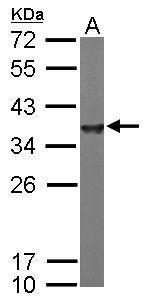Alpha SNAP (NAPA) Rabbit Polyclonal Antibody
CAT#: TA308674
Rabbit Polyclonal antibody to alpha SNAP (N-ethylmaleimide-sensitive factor attachment protein, alpha)
Other products for "NAPA"
Specifications
| Product Data | |
| Applications | IF, IHC, WB |
| Recommended Dilution | ICC/IF:1:100-1:1000; IHC:1:100-1:1000; WB:1:1000-1:10000 |
| Reactivities | Human, Mouse |
| Host | Rabbit |
| Isotype | IgG |
| Clonality | Polyclonal |
| Immunogen | Recombinant fragment corresponding to a region within amino acids 78 and 295 of alpha SNAP (Uniprot ID#P54920) |
| Formulation | 0.1M Tris, 0.1M Glycine, 10% Glycerol (pH7). 0.01% Thimerosal was added as a preservative. |
| Concentration | lot specific |
| Purification | Purified by antigen-affinity chromatography. |
| Conjugation | Unconjugated |
| Storage | Store at -20°C as received. |
| Stability | Stable for 12 months from date of receipt. |
| Predicted Protein Size | 33 kDa |
| Gene Name | NSF attachment protein alpha |
| Database Link | |
| Background | The 'SNARE hypothesis' is a model explaining the process of docking and fusion of vesicles to their target membranes. According to this model, membrane proteins from the vesicle (v-SNAREs) and proteins from the target membrane (t-SNAREs) govern the specificity of vesicle targeting and docking through mutual recognition. Once the 2 classes of SNAREs bind to each other, they form a complex that recruits the general elements of the fusion apparatus, namely NSF (N-ethylmaleimide-sensitive factor) and SNAPs (soluble NSF-attachment proteins), to the site of membrane fusion, thereby forming the 20S fusion complex. Alpha- and gamma-SNAP are found in a wide range of tissues and act synergistically in intra-Golgi transport. The sequence of the predicted 295-amino acid human protein encoded by NAPA shares 37%, 60%, and 67% identity with the sequences of yeast, Drosophila, and squid alpha-SNAP, respectively. Platelets contain some of the same proteins, including NSF, p115/TAP, alpha-SNAP, gamma-SNAP, and the t-SNAREs syntaxin-2 and syntaxin-4, that are used in many vesicular transport processes in other cell types. Platelet exocytosis uses a molecular mechanism similar to that used by other secretory cells, such as neurons, although the proteins used by the platelet and their modes of regulation may be quite different. [provided by RefSeq] |
| Synonyms | SNAPA |
| Note | Seq homology of immunogen across species: Rhesus Monkey (100%), Chimpanzee (100%) |
| Reference Data | |
Documents
| Product Manuals |
| FAQs |
{0} Product Review(s)
0 Product Review(s)
Submit review
Be the first one to submit a review
Product Citations
*Delivery time may vary from web posted schedule. Occasional delays may occur due to unforeseen
complexities in the preparation of your product. International customers may expect an additional 1-2 weeks
in shipping.






























































































































































































































































 Germany
Germany
 Japan
Japan
 United Kingdom
United Kingdom
 China
China


![alpha SNAP antibody [N2C3] detects alpha SNAP protein at cytosol on mouse lung by immunohistochemical analysis. Sample: Paraffin-embedded mouse lung. alpha SNAP antibody [N2C3] (TA308674) dilution: 1:500.](https://cdn.origene.com/assets/images/antibody/106/gtx106626-1-h.jpg?d=110x110)



